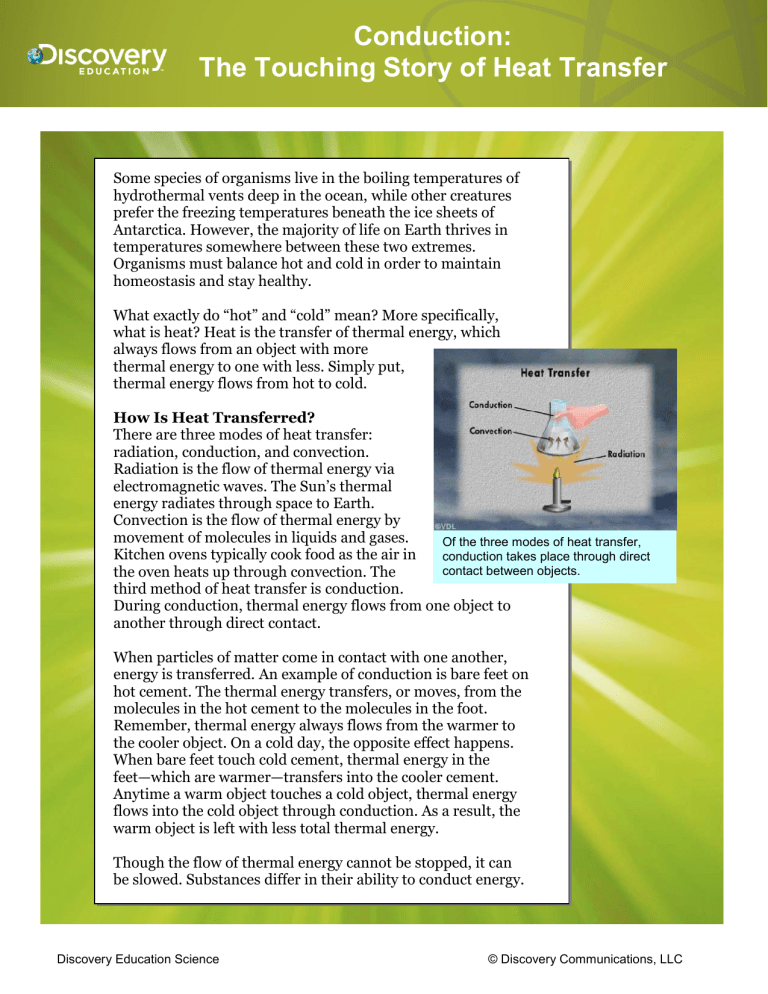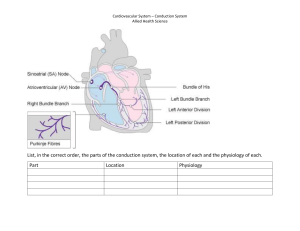
Conduction: The Touching Story of Heat Transfer Some species of organisms live in the boiling temperatures of hydrothermal vents deep in the ocean, while other creatures prefer the freezing temperatures beneath the ice sheets of Antarctica. However, the majority of life on Earth thrives in temperatures somewhere between these two extremes. Organisms must balance hot and cold in order to maintain homeostasis and stay healthy. What exactly do “hot” and “cold” mean? More specifically, what is heat? Heat is the transfer of thermal energy, which always flows from an object with more thermal energy to one with less. Simply put, thermal energy flows from hot to cold. How Is Heat Transferred? There are three modes of heat transfer: radiation, conduction, and convection. Radiation is the flow of thermal energy via electromagnetic waves. The Sun’s thermal energy radiates through space to Earth. Convection is the flow of thermal energy by movement of molecules in liquids and gases. Of the three modes of heat transfer, Kitchen ovens typically cook food as the air in conduction takes place through direct contact between objects. the oven heats up through convection. The third method of heat transfer is conduction. During conduction, thermal energy flows from one object to another through direct contact. When particles of matter come in contact with one another, energy is transferred. An example of conduction is bare feet on hot cement. The thermal energy transfers, or moves, from the molecules in the hot cement to the molecules in the foot. Remember, thermal energy always flows from the warmer to the cooler object. On a cold day, the opposite effect happens. When bare feet touch cold cement, thermal energy in the feet—which are warmer—transfers into the cooler cement. Anytime a warm object touches a cold object, thermal energy flows into the cold object through conduction. As a result, the warm object is left with less total thermal energy. Though the flow of thermal energy cannot be stopped, it can be slowed. Substances differ in their ability to conduct energy. Discovery Education Science © Discovery Communications, LLC Conduction: The Touching Story of Heat Transfer Metals, especially copper, are generally good conductors because they allow heat and electric current to flow easily through them. If you have ever touched a hot metal pan, you have experienced the conductive property of metal. Conversely, materials such as wood, rubber, and glass are poor conductors because thermal energy and electricity do not move well through them. These materials are called insulators. The purpose of insulation is not to keep the cold from entering an area. Rather, insulation is used to slow the loss of thermal energy. Animal Adaptations Living things also conduct energy. Because heat loss can be uncomfortable or even dangerous to organisms, many animals living in the Arctic have evolved insulating features. These adaptations protect them from the extremely cold temperatures of their environment. From the permafrost covering the frozen tundra to icebergs floating in Arctic waters, cold is always present. Contact with the cold ground alone threatens warm bodies. Fortunately, Arctic animals have developed insulating adaptations of fat, fur, and feathers. Consider walruses, one of the largest animals on Earth. Walruses live in the Arctic seas, mostly in open water near icy shores. Thermal energy naturally transfers from their warm bodies to their cold surroundings. Conduction occurs whenever walruses come in contact with an ice floe. Because walruses rest on these solid surfaces, body insulation is critical to their survival. The walrus’s thick layer of blubber is one of its most distinguishing features. This fat, which is about 5 to 8 centimeters thick, serves an important insulating function. Although thermal A thick layer of fat insulates walruses from heat energy still flows from a walrus’s warm loss through conduction. body, blubber significantly slows conduction. The thick fat helps the animal conserve much of its body heat. Blubber is an important mechanism for living in such cold temperatures. Discovery Education Science © Discovery Communications, LLC Conduction: The Touching Story of Heat Transfer Other animals use fur to reduce heat transfer through conduction. Thick fur helps keep animals warm and also stores pockets of air, another insulator. Woodland caribou, reindeer, and ermine all live in the Arctic zone. Each species has specialized hairs that trap air. These air pockets provide even greater insulation to reduce the rate of conduction. Snowbirds, such as snowy owls, also insulate themselves with thick layers of dense feathers. The birds' feathers even cover their legs and feet. Snowy owls puff out their feathers, providing pockets to trap insulating air. With their feather insulation, snowy owls keep their body temperature at 4 °C even when the surrounding area drops far below freezing. Conduction is an important natural process. The transfer of heat and electric current through direct contact enables many daily activities. Conduction allows food to cook in a frying pan and electricity to flow through a house. However, the loss of heat through conduction can also pose threats to living things. Fortunately, insulating materials can slow conduction when heat must be conserved. Discovery Education Science © Discovery Communications, LLC






